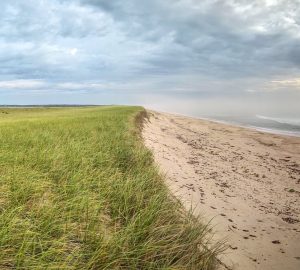This is one of those questions that may be impossible to ever get a definitive answer, and would be of dubious value even if we did get it. But there are some tools out there that can give us some information on the topic pretty easily, so let’s take a look at what they can show us.
Google Trends
The first tool is Google Trends, which is the statistics of what people are searching for on Google. It doesn’t give us absolute numbers of how many searches there were, but it can compare how popular searches were over time, and compare searches with each other.
I compared between searches for William Bradford, William Brewster, John Alden, Miles Standish, John Howland, Edward Winslow, and Priscilla Alden. If you’re interested how I ended up with those check the Methodology section below.
Bradford comes out as the clear winner, followed by John Alden, with Miles Standish close behind after the first few years. One surprising find is that searches for Bradford have a yearly cycle, with a lot more interest between September and November, but actually peaking in September – not in the month of Thanksgiving. I’m not sure why this is. The only explanation I can think of is that Bradford’s Of Plymouth Plantation is referenced near the beginning of a lot of history and literature classes, but I’m not sure why there wouldn’t be a corresponding bump in the spring for classes in that semester. Let me know if you have any explanations. See the search for yourself here on Google Trends.
We do see a clear trend line down, with less and less interest in the Pilgrims year after year. We are not going to address this any further, as it could quickly get depressing for those of us who devote a lot of time to the study of the Pilgrims….
Google Books Ngram
Ngram works in a similar way, except that it is searching to see how common your query is in the text of all the books contained in Google Books. I’m using the same list of names, from 1800 onwards, as their catalog of books before that date is small enough that the trend lines make some drastic jumps.
The placements here overall are quite similar to Google Trends, which certainly makes these results seem more reliable. Bradford gets a lot of competition for most popular Pilgrim than on the Google Trends results. This makes sense when you see the placements at the very right of the Ngrams chart, which corresponds with the last few years. Winslow starts as a solid second place, before Standish and Alden surge past him. Standish even takes the lead on several occasions. His decades long surge in popularity must be due to Longfellow’s 1858 poem “The Courtship of Miles Standish.”
The massive spike for William Brewster is an aberration – it is due to matches for a William Brewster who was a naval officer in World War II and whose name made it in to a lot of official registries. Again, you can see the full search for yourself here on Google Ngram.
The Final List
I said at the beginning that we wouldn’t be coming to any definitive conclusions, and that’s still true. But if we were, this is about what it would look like:
- William Bradford
- John Alden
- Miles Standish
- William Brewster
- John Howland
- Edward Winslow
- Priscilla Alden
- Everyone else
Methodology
I started with the list of Mayflower passengers and picked out those who I suspected would be the most famous. I then checked if the results that came up when searching those names were for the Pilgrim, or other people. I ended up excluding Stephen Hopkins and John Carver because they had too many conflicts, but even with those false positives they still wouldn’t have been in the top three. My final list you can see above. I checked the alternate forms Priscilla Mullins and Myles Standish, but they were significantly less popular – enough so that I think it is fine to just exclude them for our purposes.
Google Trends limits the number of queries you can compare at once, so Edward Winslow and Priscilla Alden didn’t make it in the graphic, but they ranked below Brewster.




